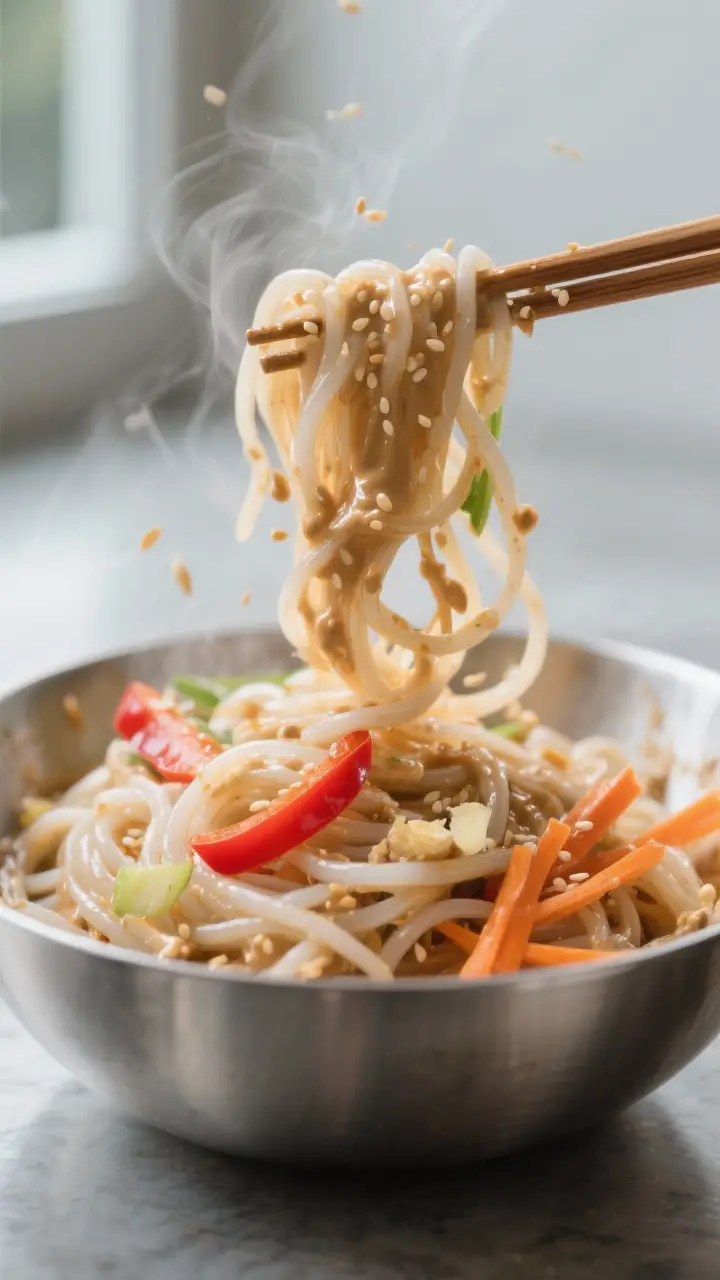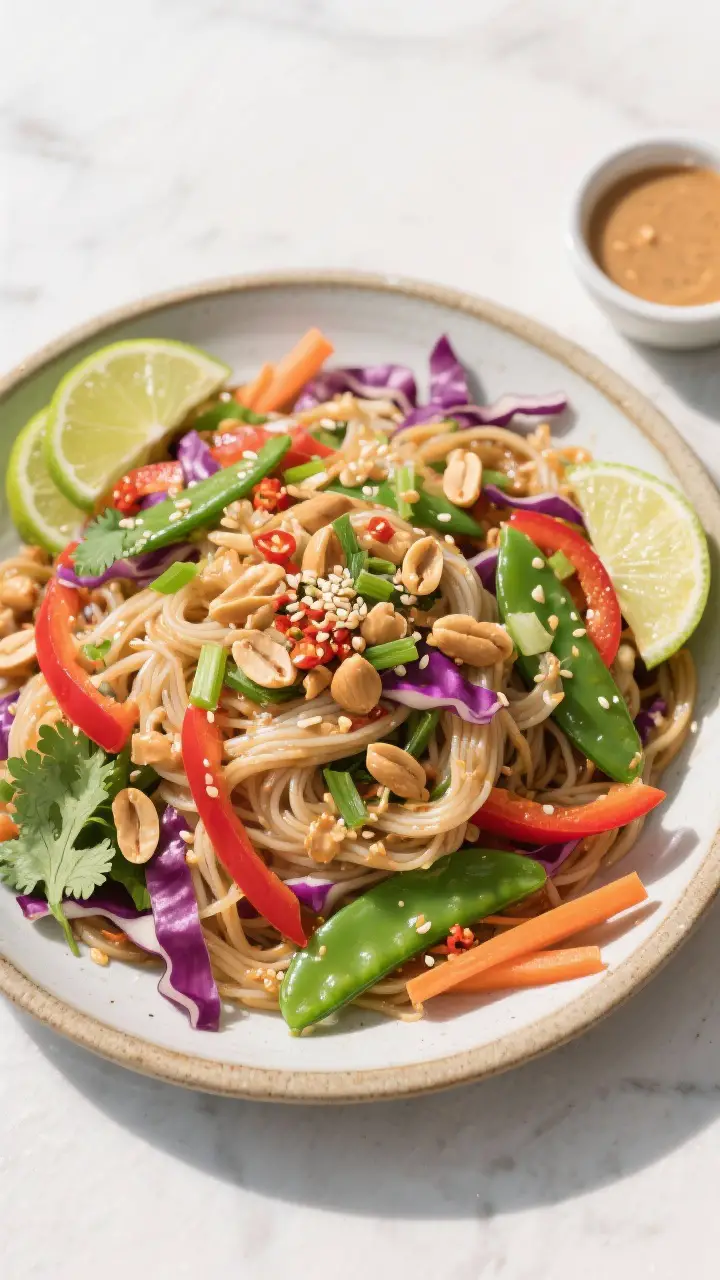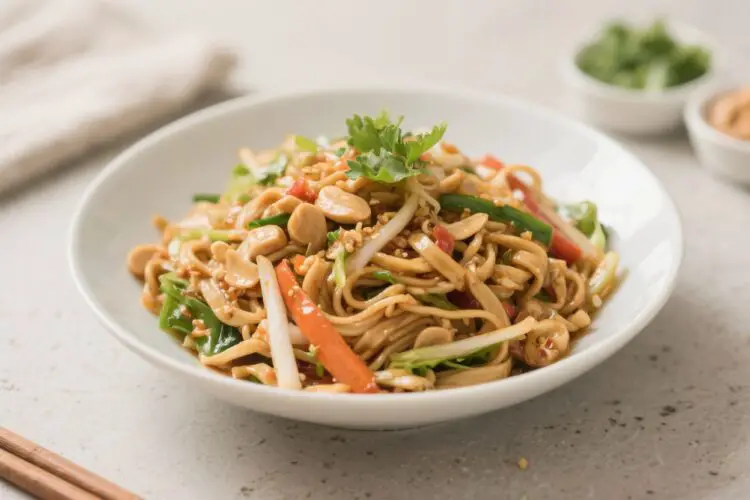This Thai Peanut Noodle Salad is the kind of dish you make once and then keep craving. It’s creamy, crunchy, and full of fresh flavor, with a satisfying peanut sauce that ties everything together. You can serve it warm, at room temperature, or chilled—whatever suits your mood.
It packs well for lunch, feeds a crowd, and welcomes all kinds of swaps. If you want something quick, colorful, and genuinely delicious, this is it.
What Makes This Special

It’s fast and flexible. The base is just noodles, veggies, and a simple peanut sauce, so you can pull it together quickly and make it your own. Use whatever crisp vegetables you already have.
The sauce is the star. Creamy peanut butter, lime, soy, garlic, and a touch of sweetness create a balanced dressing that clings to every noodle.
It’s savory, tangy, and just a little sweet.
Great hot or cold. You can toss it fresh off the stove for a cozy bowl or chill it for a refreshing salad. Either way, the flavors pop.
Protein-friendly. It’s excellent with tofu, chicken, shrimp, or edamame. You can make it vegetarian, vegan, or gluten-free with simple swaps.
Shopping List
- Noodles: 8–10 oz rice noodles (medium or thin), soba, or spaghetti
- Vegetables:
- 1 red bell pepper, thinly sliced
- 2 cups shredded cabbage (red or green)
- 1 large carrot, julienned or shredded
- 3–4 green onions, sliced
- 1 small cucumber, seeded and thinly sliced (optional)
- 1 cup snap peas or edamame (optional)
- Fresh herbs: 1/2 cup cilantro leaves, 1/4 cup mint or Thai basil (optional)
- Crunchy toppings: 1/3 cup roasted peanuts, roughly chopped; sesame seeds (optional)
- Protein (optional): Firm tofu, rotisserie chicken, grilled shrimp, or edamame
- Peanut sauce:
- 1/2 cup creamy peanut butter
- 3 tablespoons soy sauce or tamari
- 2 tablespoons fresh lime juice (plus more to taste)
- 1–2 tablespoons rice vinegar
- 1–2 tablespoons maple syrup, honey, or brown sugar
- 1–2 teaspoons toasted sesame oil
- 1–2 teaspoons sriracha or chili-garlic sauce (to taste)
- 1 clove garlic, finely grated
- 1 teaspoon fresh ginger, grated (optional)
- Warm water to thin
- Finishing: Lime wedges, extra soy sauce, and chili flakes (optional)
Instructions

- Cook the noodles. Boil according to package directions until just tender.
Drain and rinse under cool water to stop the cooking and remove excess starch. Toss with a splash of sesame or neutral oil to prevent sticking.
- Prep the vegetables. Thinly slice bell pepper, shred cabbage, and julienne the carrot. Slice green onions and cucumber.
If using snap peas, blanch briefly in hot water, then rinse cold.
- Make the peanut sauce. In a bowl, whisk peanut butter, soy sauce, lime juice, rice vinegar, sweetener, sesame oil, sriracha, garlic, and ginger. Add warm water a tablespoon at a time until the sauce is smooth and pourable, like a thin yogurt. Taste and adjust salt, sweetness, heat, and acidity.
- Prep the protein (optional). For tofu, press, cube, and pan-sear until golden.
For chicken or shrimp, season lightly and cook until done. For edamame, thaw or boil briefly.
- Toss it together. In a large bowl, combine noodles, vegetables, and herbs. Add protein if using.
Pour over most of the peanut sauce and toss until everything is well coated.
- Adjust and finish. Add more sauce if needed. Squeeze in extra lime and a dash of soy for brightness. Top with chopped peanuts, sesame seeds, and a pinch of chili flakes.
- Serve. Enjoy right away at room temperature, or chill for 20–30 minutes for a cooler salad.
Keep extra sauce on the side for drizzling.
Storage Instructions
Refrigerate in an airtight container for up to 3 days. The noodles will soak up the sauce over time, so keep a little extra sauce or lime on hand to refresh before serving.
Store components separately if you prefer less-soft noodles. Keep the noodles, chopped veggies, protein, and sauce in separate containers, then toss just before eating.
Do not freeze as the texture of the noodles and vegetables won’t hold up well.

Why This is Good for You
Balanced macronutrients. Noodles provide energy, peanut butter brings healthy fats and protein, and the vegetables add fiber and micronutrients.
Add tofu, chicken, shrimp, or edamame for even more protein.
Antioxidant-rich veggies. Cabbage, bell pepper, and carrots are loaded with vitamin C, beta carotene, and phytonutrients that support immune and skin health.
Healthy fats. Peanuts and sesame oil offer unsaturated fats that support heart health and help you stay satisfied.
Customizable for dietary needs. Swap in gluten-free tamari and rice noodles for a gluten-free bowl, or use natural peanut butter and maple syrup for a cleaner ingredient list.
Common Mistakes to Avoid
- Overcooking the noodles. Mushy noodles break and clump. Cook until just tender, then rinse with cool water and toss with a bit of oil.
- Skipping the tasting step. Peanut sauce should hit salty, tangy, sweet, and spicy notes. Adjust with lime for acid, soy for salt, sweetener for balance, and chili for heat.
- Using a too-thick sauce. Thick sauce won’t coat well.
Thin with warm water until it’s smooth and pourable.
- Forgetting texture. You want crunch from fresh veggies and peanuts. Add cucumbers, snap peas, or extra cabbage if your salad feels soft.
- Overloading with watery veggies. Seed cucumbers and pat dry to avoid a diluted sauce.
Alternatives
- Noodle swaps: Try soba, whole-wheat spaghetti, or zucchini noodles. For zoodles, salt lightly and pat dry to prevent excess moisture.
- Nut and seed options: Almond butter, cashew butter, or sunflower seed butter work well.
Adjust sweetness and salt since each nut butter tastes different.
- Protein options: Baked tofu, shredded rotisserie chicken, poached shrimp, tempeh, or crispy chickpeas.
- Vegetable variations: Use purple cabbage for color, shredded Brussels sprouts, finely sliced kale, or roasted broccoli for a heartier twist.
- Flavor boosts: Add fish sauce for deeper umami, a dash of white pepper, or a teaspoon of miso whisked into the sauce.
- Spice levels: Use chili crisp, crushed red pepper, or fresh Thai chilies if you like it hot. For mild, skip sriracha and add extra lime.
FAQ
Can I make this ahead?
Yes. For the best texture, store the noodles, vegetables, protein, and sauce separately and toss just before serving.
If you mix it ahead, keep a little extra sauce to refresh before eating.
Is this gluten-free?
It can be. Use rice noodles or gluten-free soba and swap soy sauce for tamari or coconut aminos. Always check labels on your peanut butter and sauces.
What if I’m allergic to peanuts?
Use almond butter, cashew butter, or sunflower seed butter.
The flavor will change slightly, but the sauce will still be creamy and delicious. Adjust lime, soy, and sweetness to balance.
Can I serve it warm?
Absolutely. Toss freshly cooked noodles with the sauce and veggies, and skip chilling.
It’s also great at room temperature or cold.
How do I keep the noodles from sticking?
Rinse cooked noodles with cool water, drain well, and toss with a small splash of oil. Once you add the sauce, the noodles will separate and coat evenly.
What vegetables work best?
Crisp, colorful vegetables like cabbage, bell pepper, carrots, cucumber, and snap peas. They hold their crunch and pair well with the creamy sauce.
How spicy is it?
It’s as spicy as you make it.
Start with a small amount of sriracha or chili-garlic sauce and add more to taste.
Can I use leftover chicken?
Yes. Shredded rotisserie chicken works perfectly. Toss it with a little sauce first so it stays moist.
What if my sauce is too salty?
Balance it with more lime juice and a touch of sweetener.
You can also whisk in a bit more peanut butter and warm water to mellow the saltiness.
How can I make it lower in carbs?
Use zucchini noodles, shirataki noodles, or a mix of half noodles and half shredded cabbage. Keep the veggies generous for volume and crunch.
Wrapping Up
Thai Peanut Noodle Salad is a fast, flexible meal that fits almost any day. It’s colorful, creamy, and loaded with crunch, and it tastes great warm or cold.
Keep the pantry sauce ingredients on hand, and you can make this anytime with whatever veggies you’ve got. Once you try it, it’ll earn a spot in your regular rotation.
Printable Recipe Card
Want just the essential recipe details without scrolling through the article? Get our printable recipe card with just the ingredients and instructions.

